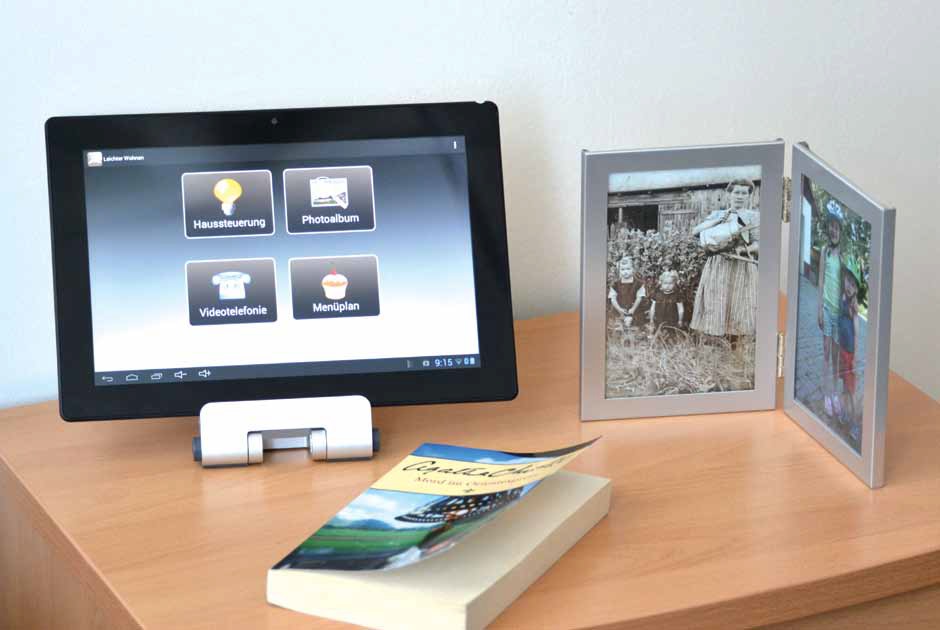moduLAAr - Austria’s First Test Region
Short Description
The moduLAAr research project was Austria’s first co-funded test region. This demonstration project aimed at measuring the impact of AAL technology on the quality of life of older adults and at enhancing the public perception of AAL in general, as well as among policy makers and different stakeholders. This goal was achieved through a large number of publications, talks and presence in various media.
The project involved equipping fifty flats (including several new buildings) with AAL technologies relating to safety, social inclusion, health and comfort. The majority of the flats were connected to a care facility and provided care services on demand from the Samariterbund in the Burgenland region. Eleven flats provided care services without a nearby care facility and fourteen flats were private properties.
A Comprehensive System with an App as Key User Interface
Technologically the system consisted of a tablet computer, a mini PC for continuous activity tracking in the living environment, an NFC-enabled blood pressure monitor, NFC-enabled weighing scales, an NFC-enabled mobile phone and a mobile emergency call system with GPS and sensors. Additionally, a cloud server was provided for formal and informal caregivers, e.g. to share photos. The app, provided on Android tablets, formed the central user interface and thus the core component of the overall system for the end user.
The average age of the participants was 71 years with a female ratio of 65 percent. The educational level was in general low (74 percent primary school, lower secondary school or apprenticeship; 20 percent upper secondary school; 2.5 percent university), and the participants had a low affinity to technology. 76 percent of the test subjects lived alone.
To measure the impact on quality of life, a number of quantitative and qualitative instruments (mainly standardised questionnaires) were used and adapted to satisfy the special needs of the target group. Additionally, affinity to technology as well as the user experience were evaluated.
Information events held at the start of the project at every trial site served to recruit participants and present the AAL technology used. Following collection of baseline data and installation of the technology, the participants were visited at regular intervals to collect additional data, and also to clarify and resolve any technical or usability issues.
From Qualitative Evaluation to Political and Legal Frameworks
A final discussion in focus groups completed the qualitative evaluation in terms of the impact of AAL on quality of life and health as well as the usability of the system. Another aspect of the evaluation was focused on the existing infrastructure on-site and its suitability for older adults.
The investigation also explored the existence and usage of political provisions designed to improve the situation of the elderly and support their access to assisting technologies. Professional recommendations, federal and regional policies as well as the relevant legal framework for establishing and financing innovative ICT-based forms of dwelling for specific groups of people in need of care are, in principle, ready for implementation.
However, municipalities, organisations or regional authorities so far only rarely use the opportunities provided by the care fund for developing and co-funding innovative forms of dwelling.
Positive Effect of AAL Technology
The data clearly showed the positive effect of AAL technology on quality of life in an age group where maintaining the quality of life can already be seen as a success. Assistive technologies had a verifiable positive impact by satisfying the need for safety and supporting selfassessment of the participants’ health status through regular measurement and visualisation of vital parameters (weight, blood pressure, blood sugar).
Participation in the project also led to an increase in social interaction in general and provided a welcome change to daily routines. The project involved the development of a multi-stage exploitation strategy to enable a low-cost entry into the use of AAL technology for end users by initially promoting lifestyle and health aspects.
The modular architecture of the system allows easy extension in line with changing user needs later on. AIT Austrian Institute of Technology has already taken concrete steps towards commercial exploitation in cooperation with business partners based on experience from moduLAAr and other projects
Project Partners
Consortium Manager
AIT Austrian Institute of Technology GmbH
Further Project Partners
- Samariterbund Burgenland
- University of Applied Sciences Technikum Wien
Contact Address
Project Coordinator
DI Dr Johannes Kropf
E-mail: johannes.kropf@ait.ac.at

